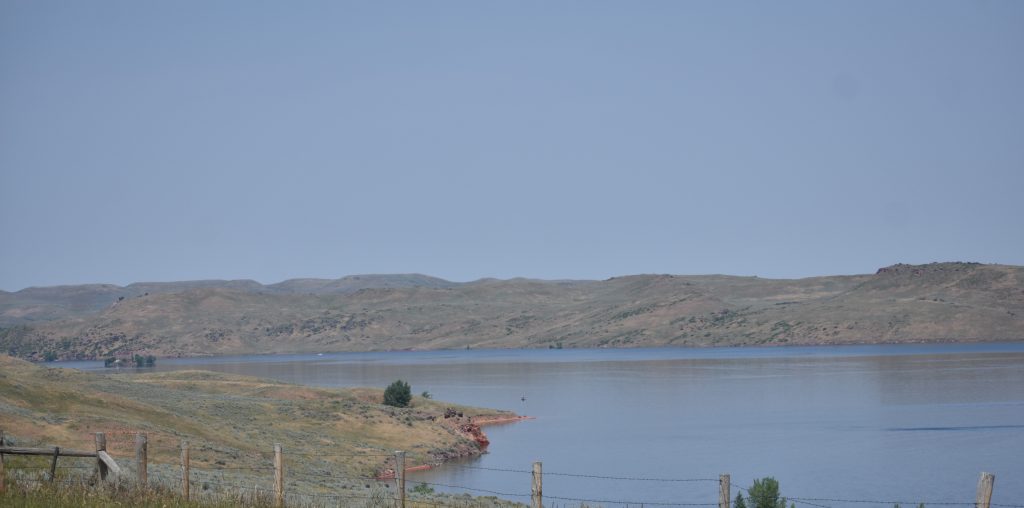alt
History of Water is Topic of Explore History Program

The Powder River near Arvada
The Sheridan Community Land Trust Explore History program, in collaboration with the Hub on Smith, held its February program at the WYO on Feb. 8th. Carrie Edinger, Historical Program Manager said that the move to the WYO was made due to the popularity of the programs, saying that they were outgrowing the Hub dining room.
Edinger presented this month’s program titled, The History of Water in Semi-Arid Southeast Sheridan County. Edinger introduced her program this way,
Edinger added that by the late 1800s, the Native American’s began to feel the impact of the westward expansion. During the California Gold Rush many travelers came across Wyoming, and competed with the Native Americans for the natural resources. This caused many tensions between the two groups.
On September 8, 1851, the US Commissioner of Indian Affairs arranged a huge gathering at Fort Laramie to assign territories for each tribe, to help maintain the peace and give each tribe their own hunting grounds. This treaty, called the Horse Creek Treaty, was moved from Fort Laramie to the mouth of Horses Creek, 30 miles away, as there was not enough pasture for all the various tribes horses.

The treaty used the existing rivers as borders for the 38 million acres of lands reserved for the tribes. The Power River became the boundary between the Lakota and the Crow. The Power River, the Yellowstone, Twenty-Five Yard Creek, and the Mussel Shell River formed some of the boundaries.

The Crow’s name was in a reference to one time when a war party got caught in a snowstorm near Power River and some froze to death.
In the mid-1800s the white settlers in Wyoming Territory claimed the water on a first come, first serve basis, and the territorial government began to write down the people’s claims on the water. But, that didn’t stop people from arguing over the water, and the disputes went to the courts.
In 1888, Elwood Mead was hired as the Wyoming Territorial engineer. He came from Indiana, where the problem was often too much water, unlike Wyoming where there was seldom enough. He worked for a time on the front range in Colorado, researching the water right problems there.
When he came to Wyoming he had to figure out which claims were recorded in the Wyoming books. He came up with the idea that no one could claim water without a permit. They set up a board to listen to disputes rather than the courts. The water laws were voted into the Wyoming constitution in 1890.
Edinger also spoke about the Pratt and Ferris Cattle Company, who were instrumental in establishing some of the early irrigation ditches in southeastern Sheridan County in 1884. At first Pratt and Ferris were a freighting company, and in 1879 the company went into the cattle ranching business in the Clearmont-Ucross area along Clear Creek. One of the Pratt and Ferries businesses was furnishing beef to the forts and the Indian agencies.

Some of the partners in the Pratt and Ferris Company were James H. Pratt, Cornelius Ferris, and Marshall Field, who later started Fields department store in Chicago. Levi Leiter, who was a well-known rancher in the Clearmont area, was Field’s senior partner in the dry goods store in 1865. Leiter later sold out his share to Field, but it was through this connection that Leiter came to invest in the Pratt and Ferris cattle company. In 1898 Pratt and Leiter bought out rest of investors. These men were American entrepreneurs of the era, and Field was one of the richest men in Chicago and the United States.
Edginger talks about the irrigation project that Leiter started in the Clear Creek Valley.
In 1897 and 1898, Leiter attempted to corner the wheat market and was briefly the largest individual holder of wheat in the history of the grain trade, action taken against him by his competitors and they broke his corner on that market.
At one time, the Leiter Estate ran from the Johnson County line near Ucross, east to Leiter. The estate installed the concrete grain elevators along highway 14-16. In 1904, when LZ Leiter died, and the value of the estate was between 50 and 100 million dollars. Leiter’s children brought a lawsuit against the estate and the litigation eventually lasted eight years and cost millions of dollars.
Joseph Leiter, LZ’s son, continued be a part of the Clear Creek Valley, working on irrigation and farming instead of stock growing. One of the crops that was raised for years in the valley was sugar beets. Edinger explained,
Many Volga German families emigrated from Russia, where Catherine the Great had invited then to the Volga River to farm during the 1760s. In the late 1800s, many immigrated to America, where they retained their German language and customs. Many of these farmers settled along the Clear Creek Valley and began to grow sugar beets. Edinger added that the planting, thinning and harvesting the beets required a lot of manual labor. She also said that during the World Wars, many of the German farmers faced prejudice from the other residents in the area.
Edinger’s program demonstrated how water, from the Native American’s river boundaries to water rights and irrigation projects, has affected the history and landscapes of Sheridan County.

